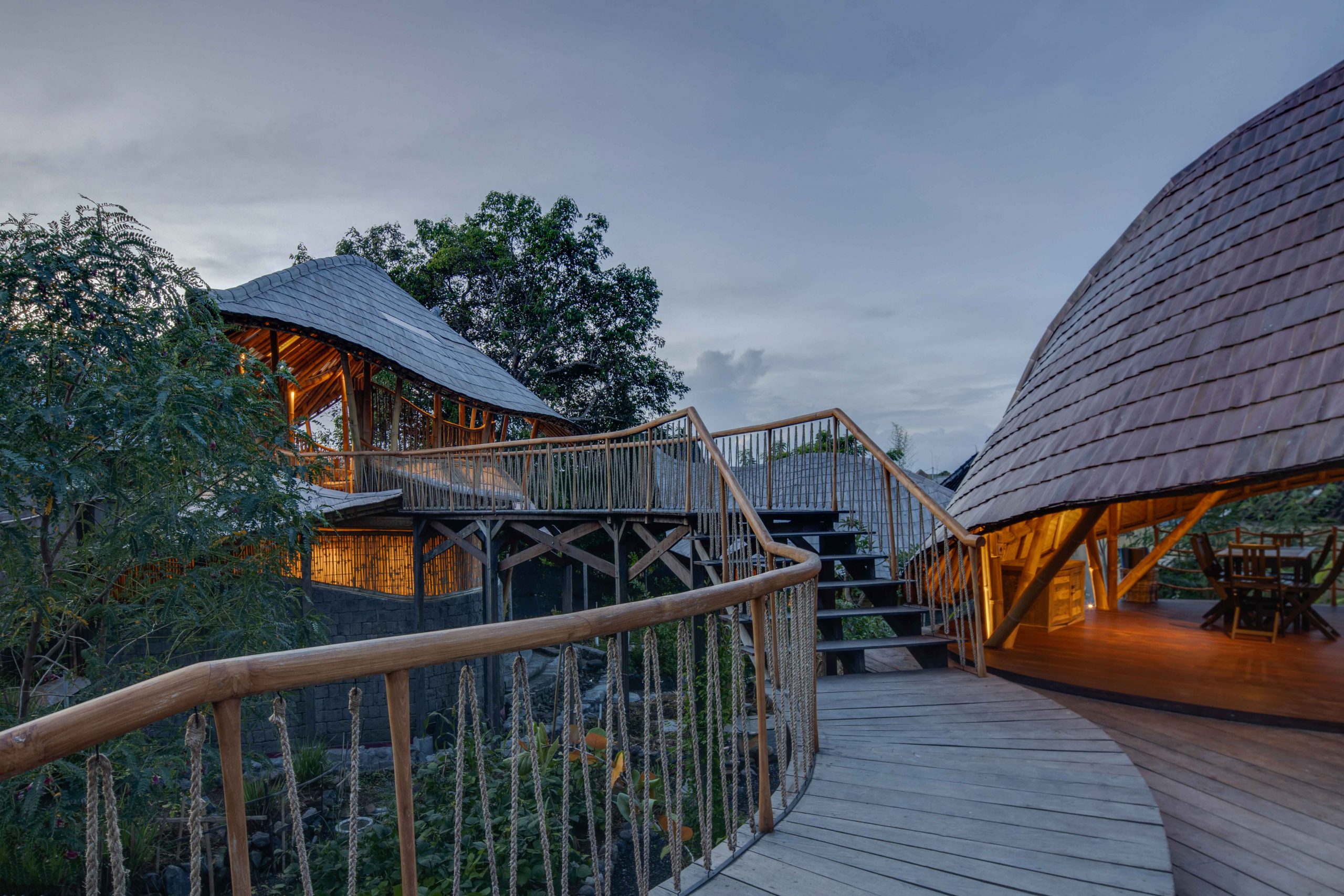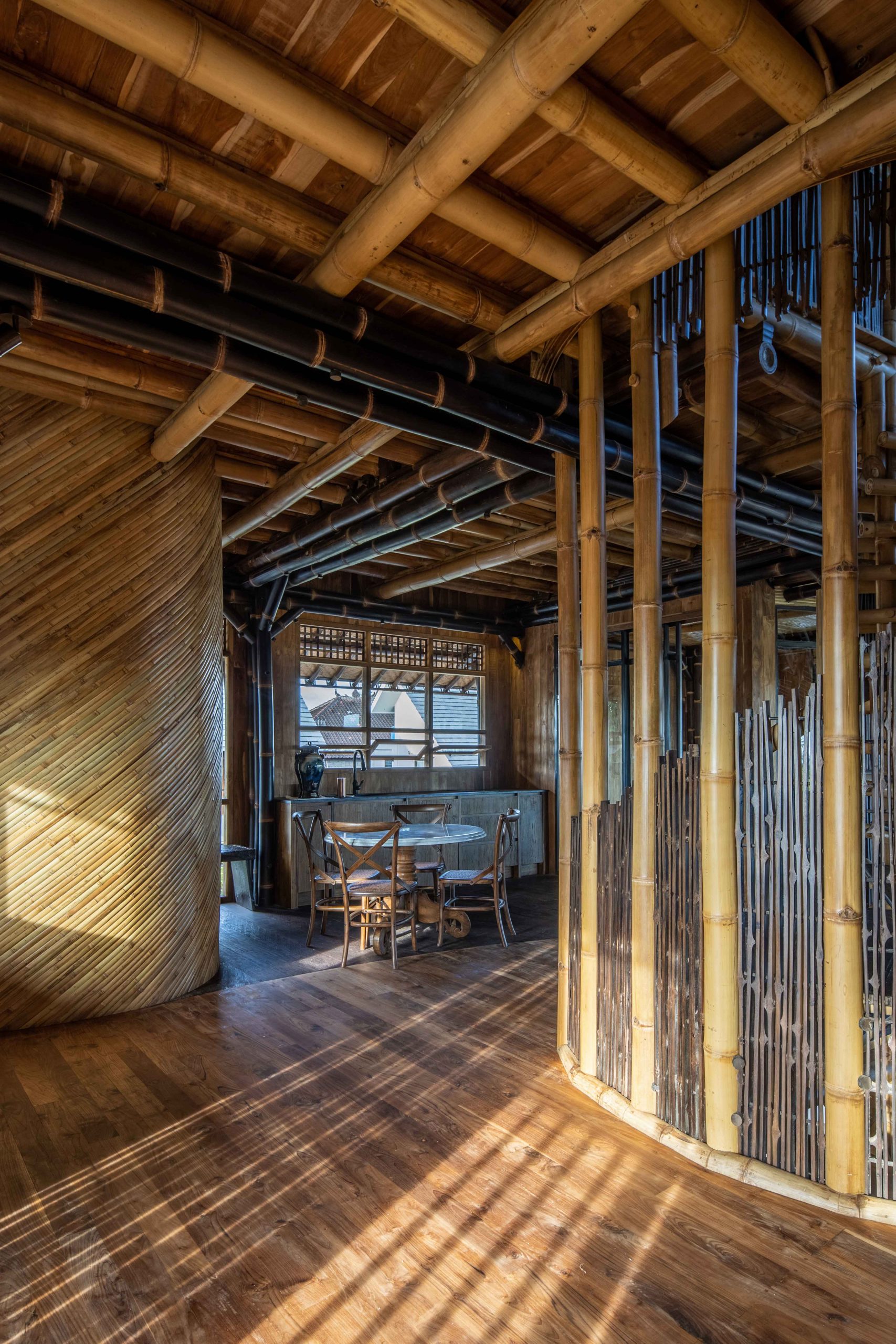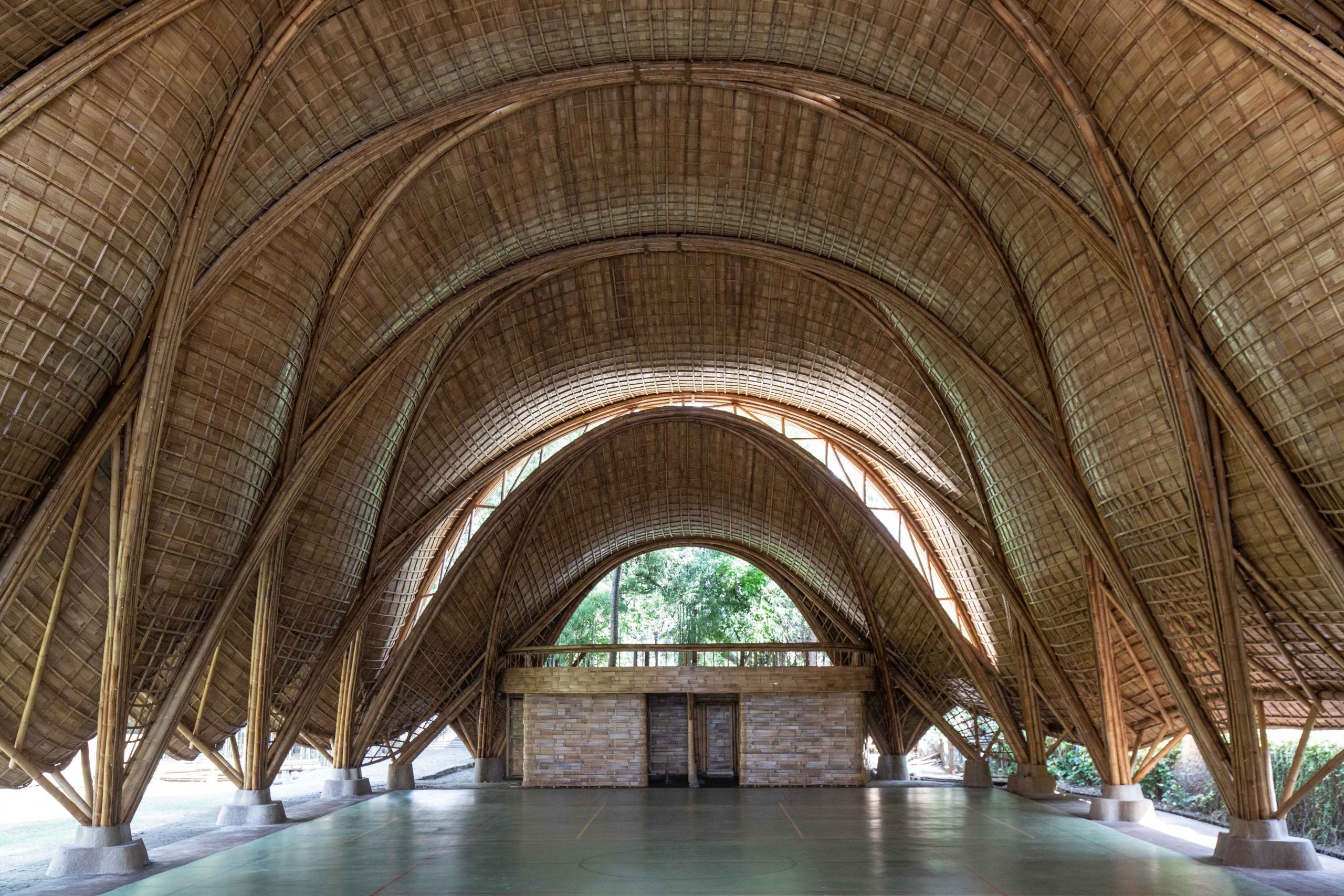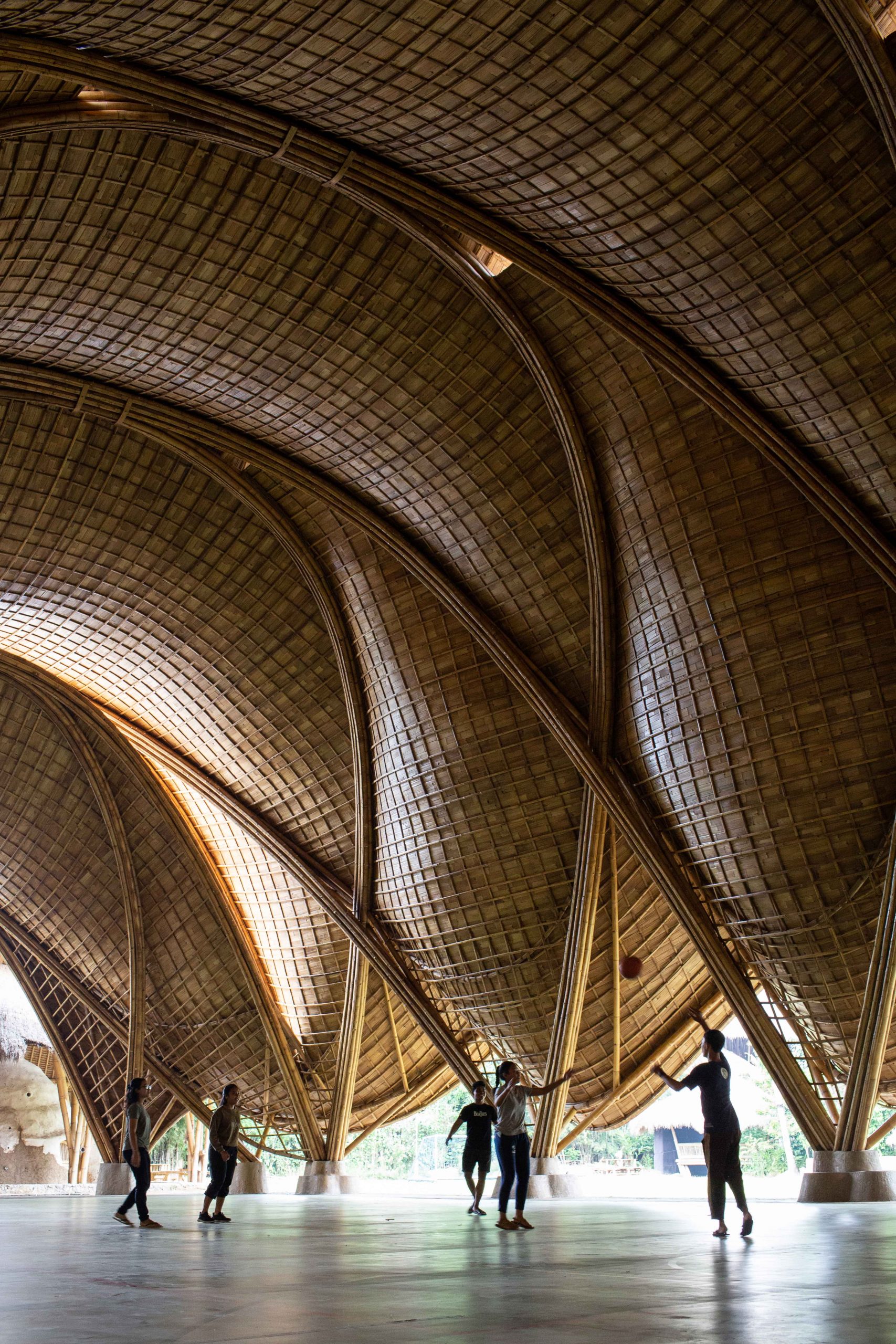Elora Hardy leads an international team in creating home hospitality projects, school campuses, private homes, and bespoke furniture collections made of natural materials and built in ways that reconnect one with nature. Asia Designers Directory interviews Elora, the entrepreneurial and innovative founder and creative director of IBUKU, to find out about her influences and vision.
Can you tell us about your growing-up years in Bali and how it has influenced your design style today?
Growing up in Ubud, Bali, I spent my time in the garden, rivers and the ricefields, escaping into nature. I imagined living in a mushroom house like in fairytale storybooks, complete with dormer windows and red polka dots like in the illustrations. When my mom, Penny Berton, had the opportunity to move us out of our rental house and build our own home, she took my dreams seriously, and was worried about how to realize them, and whether to take them literally. I remember negotiating with her about it, about the materials and colors and window shapes. A couple of years later she had saved up the money and put the building process in motion to create a bamboo arched structure similar to a traditional lumbung rice hut, but rounded as a dome, and a local thatch roofing material. My mom later remembered the craftsmen’s enthusiasm in figuring out new techniques to realize it. So I think that worked out pretty well. I think we just didn’t realize or consider that unusual for a mother and daughter to be designing our home together. She made it feel absolutely natural that I should have a say in the shape of our home, and that my ideas were valid and worth realizing. She involved me in the process of adapting my dreams to reality as we made them come true.
At 21 while in art school I realized that designing structures and spaces would be a meaningful way to create, but was swiftly talked out of considering architecture school by some architect friends. So I haven’t been trained in architecture and I don’t consider myself one, while leading the creative direction for our team of designers and architects. So we work in instinctual and perhaps irreverent ways that I hear are different from the norm.
- Taman Villa in Bali (Photo credit: Indra Wiras)
- Taman Villa in Bali (Photo credit: Indra Wiras)
- Taman Villa in Bali (Photo credit: Indra Wiras)
- Taman Villa in Bali (Photo credit: Indra Wiras)
Subsequently, you relocated to New York, where you worked for a famous brand. Did living in a cosmopolitan city and working for a lifestyle brand shift your design perspective?
New York itself was intense and exciting, also challenging and alienating. I felt proud of surviving there and privileged to have the opportunity to learn ways to be tough and resilient. There’s a sense in New York that everyone is there to strive toward excellence. In fashion, I saw how the forces of artistic creativity and business merchandizing strategy must vie for priority. The goal was always to anticipate what our customer would want to wear before she knew it herself, without pushing forward too fast and while also offering the safe and comfortable option. I see structures as layers of ourselves, similarly to how we relate to the clothes we choose to wear. So I’ve come to recognize more and more lately that people need comfort and reassurance of shelter before they can embrace the unconventional and open up to new experiences. The natural world can be comforting and healing, but to see that we need first to feel we are safe.I feel an advantage in having crossed disciplines, I’m interested in cross pollination. Simultaneously,expertise is essential — to create anything new requires collaboration among a variety of people with deep expertise. But each must have an open mind, they must be hungry to discover something new. We push and question each other, challenge assumptions, and keep looking out of the corner of our eyes for falling star ideas.
Years later, you founded IBUKU when you returned to Indonesia. What prompted this decision and why did you make bamboo central to your designs?
I needed to do something that fit in with the way I hope the future will be. That meant using sustainable materials, something that I couldn’t find access to in the fashion world at that time. I was excited by the unparalleled sustainability of bamboo, and more importantly I was blown away by the beautiful designs that the team who built Green School had come up with. My dad John Hardy and stepmom Cynthia Hardy were always up to big things, but the bamboo structures of the campus were mind blowing at that time. After Green School was built, that team needed opportunities to continue designing and building. Even though I had no architectural, construction, or business training, I felt I had to find a way to keep that project moving forward, and to keep this new art form alive. If people with the connections and resources and safety net I have can’t find ways to devote our skills towards sustainability, then who can? Inspired by the culture and landscape, I made a commitment to help Balinese artisans evolve their skills into a new methodology for the world, and over the past decade Bali has become a global centre for bamboo building and innovation. My brother Orin together with his wife Maria have created a course called Bamboo U, where we share the knowledge that our architects and craftsmen have developed with people from around the world, to spark further possibilities in the bamboo world and beyond. Now Bamboo U is online, available to people around the world, and we’ve just launched a Spanish language version.
- The Arc at Greenschool in Bali (Photo credit: Tommaso Riva)
- The Arc at Greenschool in Bali (Photo credit: Tommaso Riva)
- The Arc at Greenschool in Bali (Photo credit: Tommaso Riva)
Your ground-breaking designs blur the lines between indoors and outdoors, featuring open floorplans with no walls to allow the cool breeze in. Can you tell us more about this design process and what it takes to make such buildings materialize?
When properly treated, bamboo structures can last a lifetime or more, as properly maintained wooden structures can. But they need to be built in a way that’s suitable, and designed in a way that’s aligned with their strengths. Traditional Balinese buildings out of bamboo followed the mode of wood, and weren’t aligned with how bamboo could be expressed or how it needed protection. Our design work with bamboo doesn’t look original just because we felt like it should – it’s because it was necessary to listen to the material in order to design what it would be best at being. And we increasingly add an element of play, to stretch its possibilities, and science, to develop its range with technology.
Our design process parallels all of the steps that architecture must, while also delving further into conversations about materiality choices, the emotional goals and psychology of space, how to support our relationship with nature and with each other, and the value of texture and the artisanal.
We love to design onsite, when possible. Even when we need to plan in advance, to develop the design on paper, for approvals and costings and material preparation for the construction schedule, we aim to plan some flexibility into our process. If we are using a piece of bamboo or a raw-edged wood or stone we must acknowledge that those are not made-to-order. They are selected with care, and will vary from what is planned, some things creating challenges onsite and sometimes offering unexpected un-plannable advantages. Especially when designing into a natural contoured landscape, it’s impossible to precisely survey the site, so we must respond to the existing conditions and improvise where necessary. Even when planning on flat land, defining the exact position of an organic curve is challenging. Even with skilled builders, there is likely to be some variation between the drawings and what is built, especially with natural materials. When we identify a situation where we know the effort to plan and anticipate will be futile, we step back from trying to control it and instead we draw a bubble around a certain area of the plan, to announce from the early stages that we are saving that part to be developed onsite, and we coordinate with the construction and artisan teams to mark it onsite, create templates to follow instead of drawings, and then in turn template the furniture against the site rather than from the drawings. We can then follow those templates in the workshop, and finally assemble and install (and likely adjust again!) onsite. Our care and attention to detail is extreme. The intersection of the variety of types of materials intensifies this. Like a dance that is partly choreographed, partly improvised. From a craftsman’s perspective, constant improvisation is a job requirement. Each piece of bamboo is a new and unique dance partner, he must adjust to fit with them, accommodate them, find a flow with them, and plan them into the overall dance of the item. The same when creating a building. Each pole or split of bamboo is noticeably itself, the diameter, the spacing of the nodes, the surface color texture varies. I believe this is why we feel at ease around natural materials, it is comforting to be among other nature-made individuals.
Was it difficult to convince clients to use bamboo at first? What are some challenges of building eco-friendly structures?
12 years ago when we first began designing homes, the clients we attracted were inevitably adventurous outliers. It was an immense challenge to fulfill the goal and create entire functional homes from one material, based on the example of beautiful open-air structures at Green School. Having mastered it thru working almost entirely with bamboo for a decade, we have lately broadened our palette to work with many natural materials, orchestrating each into the part of the building where it belongs and can best serve the experience we aspire to create. Now we are designing for projects around the world, including in places where bamboo isn’t a realistic option.Our clients choose us because they love and recognize that our approach will be able to fulfill their practical needs, as well as their emotional aspirations. There is always a brief with a unique and specific set of requirements, just as there is always a site with the sun path above, neighbors beside, and earth contour below. We are not painters, we do not hope for a blank canvas on which to place our imagination. Our goal is to gather up those ingredients and then to anticipate and fulfill the future users’ desires and aspirations. Our clients also often enjoy seeing the process as the items are created, and sharing these steps with them fosters appreciation, especially in the hand craftsmanship.
We love spaces that feel intuitively comfortable to humans, beyond taste or style or culture. Humans inevitably recognize as familiar settings with natural elements. We also notice instinctively when something is made by humans while in alignment with the way nature does things. I believe a human-made space that feels natural has even more impact on us than being in the most beautiful forest, because it proves to us subconsciously that humans can build a beautiful world and healthy future. The challenge has been to create dynamic architectural bamboo structures that are also comfortable, cozy homes. It’s one thing to create a sculptural shell, it’s another thing to live in it. We want the best of both worlds, to be uplifted and swept away by the grandeur of the architecture, to feel the breeze and light play through the space, and also be sheltered from the bugs and to be able to batten down the hatches and turn on the Air Conditioning. Bali inspires balance, and what we do to achieve it is to think as creatively as possible. We have built big woven baskets as cozy TV rooms — and sometimes even as bedrooms– with beautiful glass moon doors so that you could look out at the view. We lined them with hand-made banana fiber paper to keep the cool air in.
Some of your iconic works include Sharma Springs, Eclipse House, and Green School. What are key considerations when working with nature? How has these buildings impacted the local communities?
Where we’ve built in Bali is often forested and periodically rainy. The weather is quite mild here with some hot days but never extremes of cold so the lifestyle is conducive to indoor-outdoor living. We sometimes build on stilts, for example to perch over a steeply terraced site, to make use of land with beautiful river valley views without needing the conventional bulldozing and retaining. Other times we have the ground floor and walls of a structure out of stone, which can feel wonderfully grounding and balance the airiness of the bamboo. Often we also incorporate wood, when we can be sure it didn’t come from a rainforest. Most buildings in the world today are so defensive that they shut us off and disconnect us from nature, and from each other. I always recommend creating a balance of enclosed and open-air spaces in a home. We need to first feel protected, from heat and insects especially, before we can feel comfortable and at ease in nature, but the key is not to overprotect.
Bamboo is unsurpassed as a sustainable building material. That the primary structure and most of the walls and floors are entirely bamboo, all grown nearby wild in the river valleys and in homestead plantations, and each pole growing to full maturity within 4 years, is the core of our sustainability. We design light on the land and use hand craftsmanship, with hand held power tools, to build. Drawing attention to the possibilities for architecture that does good, not harm, is dear to our hearts. If we can build palaces from a grass that grows in our back yards, what else is possible?
- Area 15 in Las Vegas
- Area 15 in Las Vegas
What is next for your practice?
Our upcoming projects are more often international, and we are excited to collaborate with teams in Central America, Europe, and across Asia to realize them. Often we are approached to create the concept for a resort, home or feature structure, and given the freedom to study and propose the ideal local materials to use. We collaborate with local architects to consider the palette and coordinate with the realities of each local building code and engineering needs. Usually, but not always, we incorporate bamboo, it depends on the possibilities and practicalities of each location, the available techniques or skill of the craftsmen. Even in cold climates, bamboo can play a role in harmony with other materials that insulate, and bamboo projects can absolutely be realized in places where there isn’t a local industry or skill, so utilize laminate systems similar to wood laminate. We often plan hand-crafted elements into the interiors, perhaps sending those from Bali. We have learned so much from Bali, from bamboo and from nature, now we’re opening the aperture to interpret many materials, in many places









